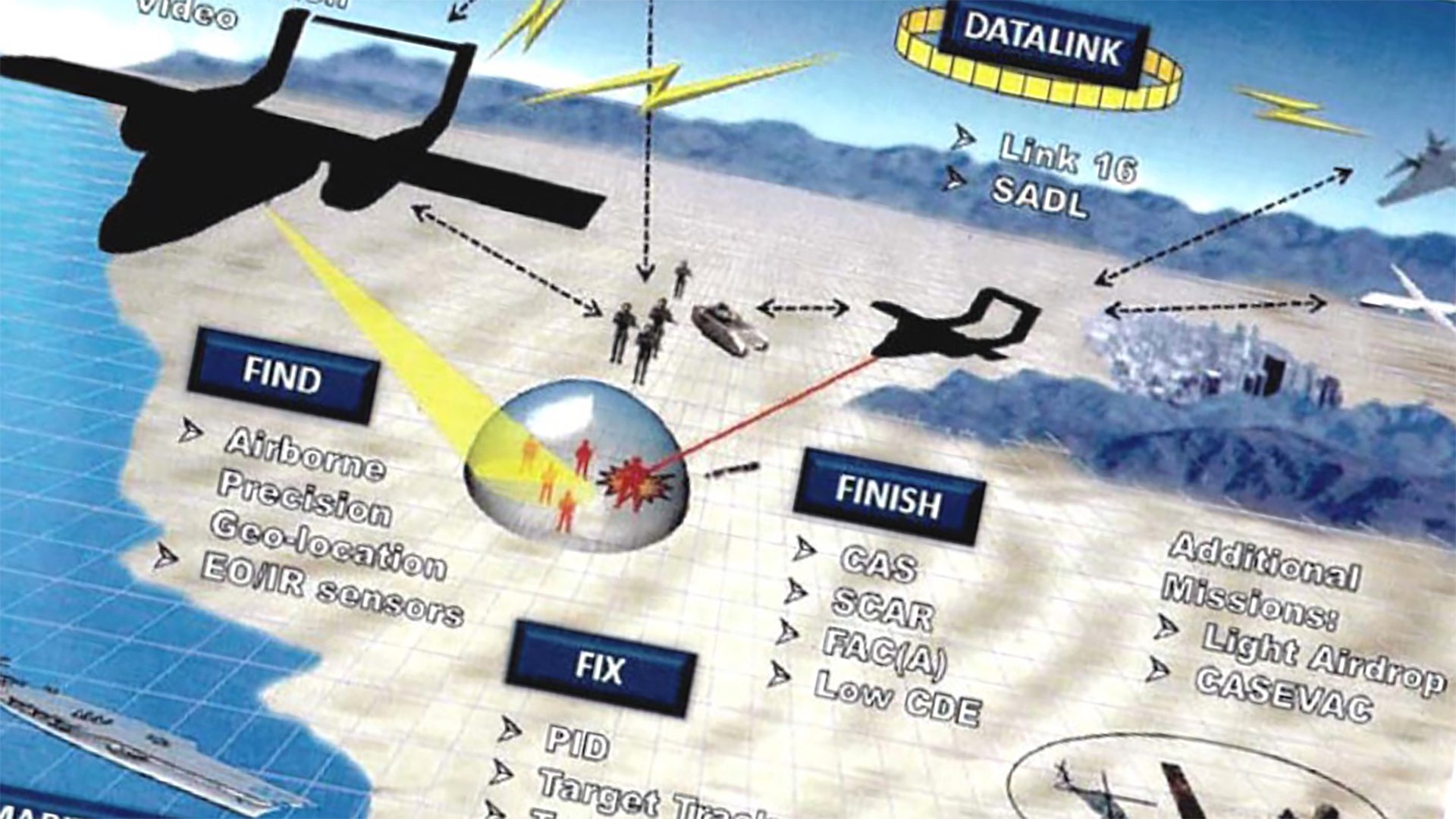Thanks to a newly released briefing, we can now reveal even more information about the pair of OV-10 Broncos that the U.S. Special Operations Command sent to Iraq to hunt ISIS. This includes information about the unique configurations of these Vietnam-era planes, such as their ability to track targets by homing in on cellphone signals and to share data across multiple networks. We also found out about the extensive testing that preceded their trip to the Middle East, and the lessons learned from employing a updated light attack aircraft on a modern battlefield.
In July 2017, the Pentagon’s Joint Requirements Oversight Council formally directed U.S. Special Operations Command, or SOCOM, to conduct a “limited objective experiment” to see if a light turboprop aircraft could provide more flexible and responsive close air support and limited strike capabilities both when operating from remote or austere locations – or even an aircraft carrier, amphibious ship, or sea base – or in support of a larger force, according to the undated presentation, which we obtained via the Freedom of Information Act. The theory, which is one we have argued for more than once ourselves, was that such an aircraft could be a cost-effective tool for limited conflicts that would also free up far more costly higher performance or specialized aircraft from having to conduct these missions.
The aircraft would be focused on conduct counterinsurgency and irregular warfare missions working with both special operations forces and conventional troops. If possible, it would still be able to operate safely in contested or degraded environments and maybe even generate very little noise, enabling it to orbit discreetly above a specific target area for a protracted period of time.
Optimally, it would have a mixture of weapons and sensors that would allow it “find, fix, and finish” the enemy independently in cooperation with other manned or unmanned aircraft and be easy to deploy and operate by a small number of personnel even with limited facilities and support. We know that when it came time for the final OV-10G+s to go down range, they did have an impressively small footprint that allowed them to quickly self-deploy from one location to another, even improvised airfields.
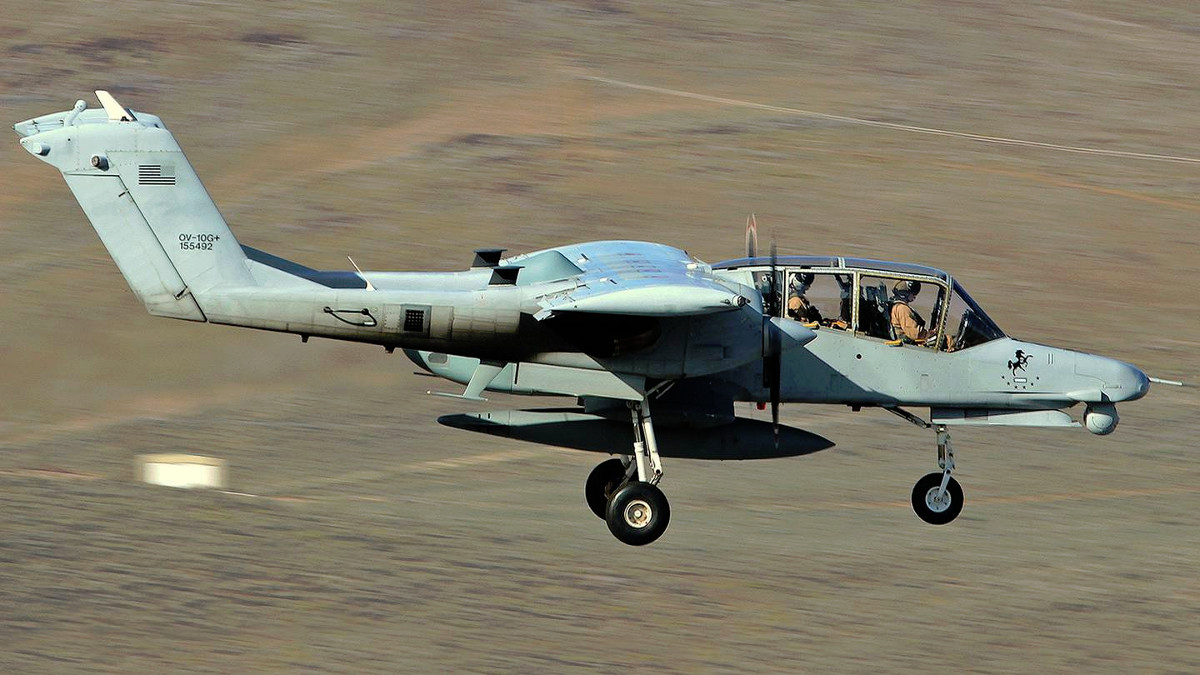
This experiment, also known as Combat Dragon II, had been in the works since the late 2000s, having built off an earlier U.S. Navy project called Imminent Fury. The new test program had run into opposition from Congress owing to a political dispute over the preferred aircraft, the Brazilian-made EMB-314 Super Tucano. You can read about this particular saga in detail here.
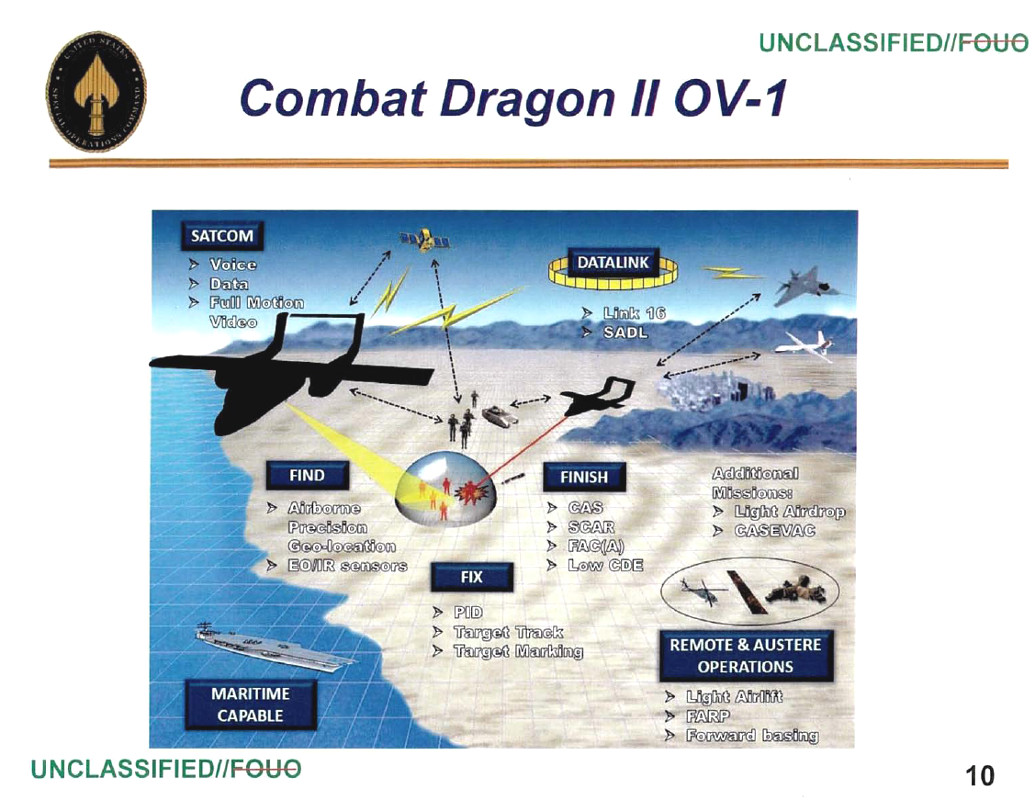
The project was always “aircraft agnostic,” according to the briefing, meaning that the chosen platform was not as important as testing the associated doctrine, tactics, and other procedures. SOCOM eventually decided to enter into a three-way partnership with the Navy and NASA to modify the pair of OV-10 aircraft into the new G+ configuration.
“OV-10s did provide numerous capabilities,” the presentation notes. “However[, they were] primarily selected based on availability and no acquisition or leasing costs.”
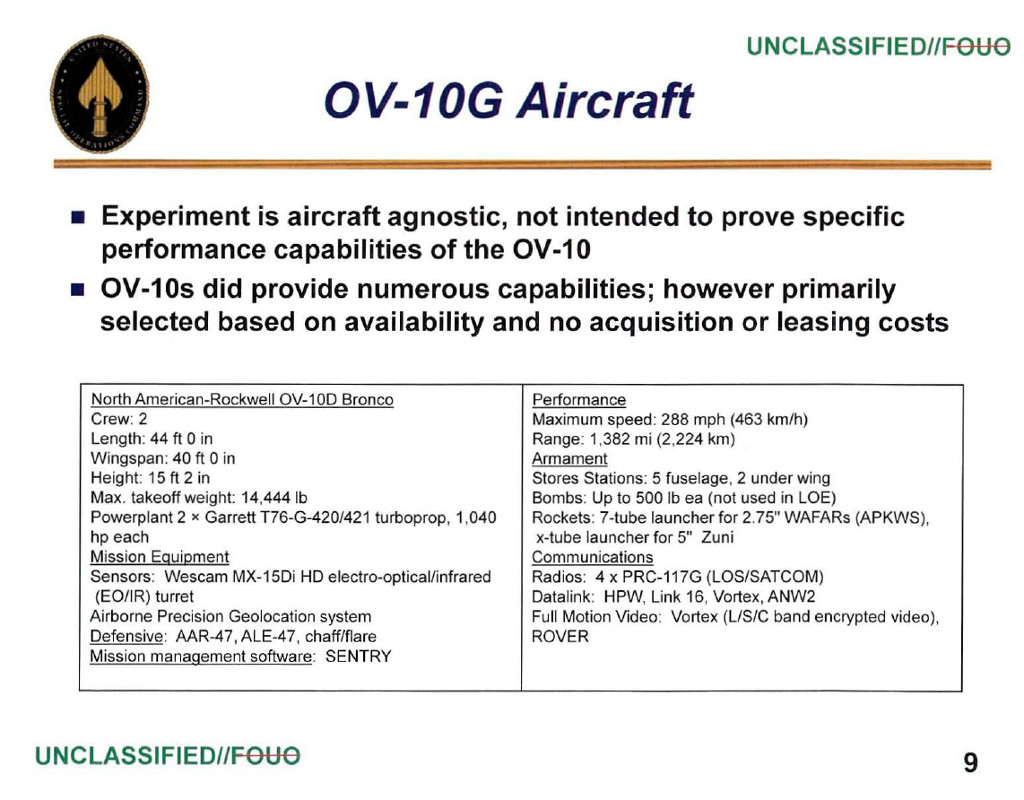
NASA agreed to turn over the Ex-U.S. Marine Corps planes, which it still has for aerospace research purposes, in exchange for the guarantee that it would get them back with all new glass cockpits and other basic improvements. You can read more about how that arrangement came to be here.
The Naval Air Systems Command handled the modifications to the two aircraft, which cost approximately $20 million in total. This package included various sensors, weapons, and self defense systems, such as missile approach warning sensors and decoy flares.
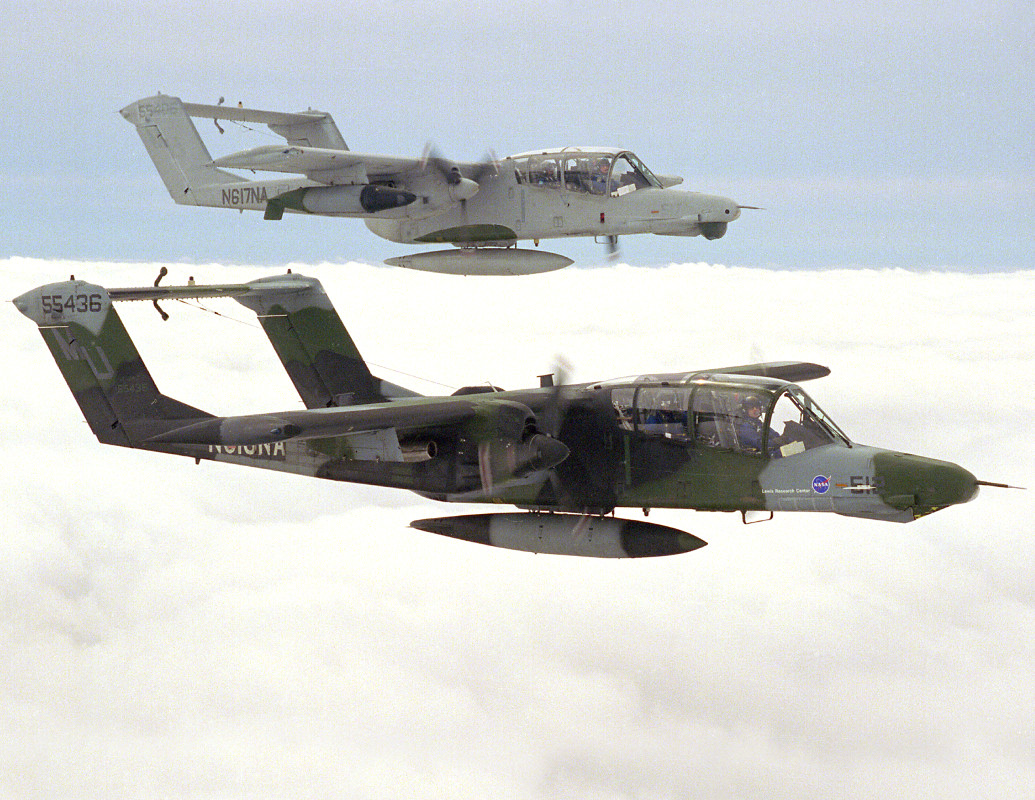
The most obvious part of the sensor suite was the high-definition L3 Wescam MX-15HD sensor turret, which has electro-optical and infrared full motion video cameras, the ability to produce high-resolution still imagery, and a combination laser range finder and designator. The primary weapon during the aircraft’s deployment to Iraq was 7- and 19-tube rocket pods loaded with the highly accurate laser-guided 70mm Advanced Precision Kill Weapon System II rocket, or APKWS II.
As our own Tyler Rogoway wrote in 2016:
“The Broncos were used to find, fix and finish the enemy. In the past, this process was largely accomplished by at least two very different aircraft and platform communities, both of which usually had their own unique command and control structures. By condensing all the required capabilities into a single platform—the OV-10—the kill chain could be drastically compressed and save gobs of money in the process.
“The truth is, OV-10s weren’t really close air support aircraft in the traditional sense at all—they were manhunters.”
But we now know the exact configuration of the amazingly intricate communications and data sharing system in each aircraft the truly allowed them to perform this mission. The planes had data links that could pass audio and video across four different network protocols, including Link 16 and Situational Awareness Data Link (SADL), both of which are common on many U.S. military tactical aircraft although rarely are they installed together on the same aircraft. The Advanced Networking Wideband Waveform (ANW2) typically found on ground vehicles was also installed on the Broncos.
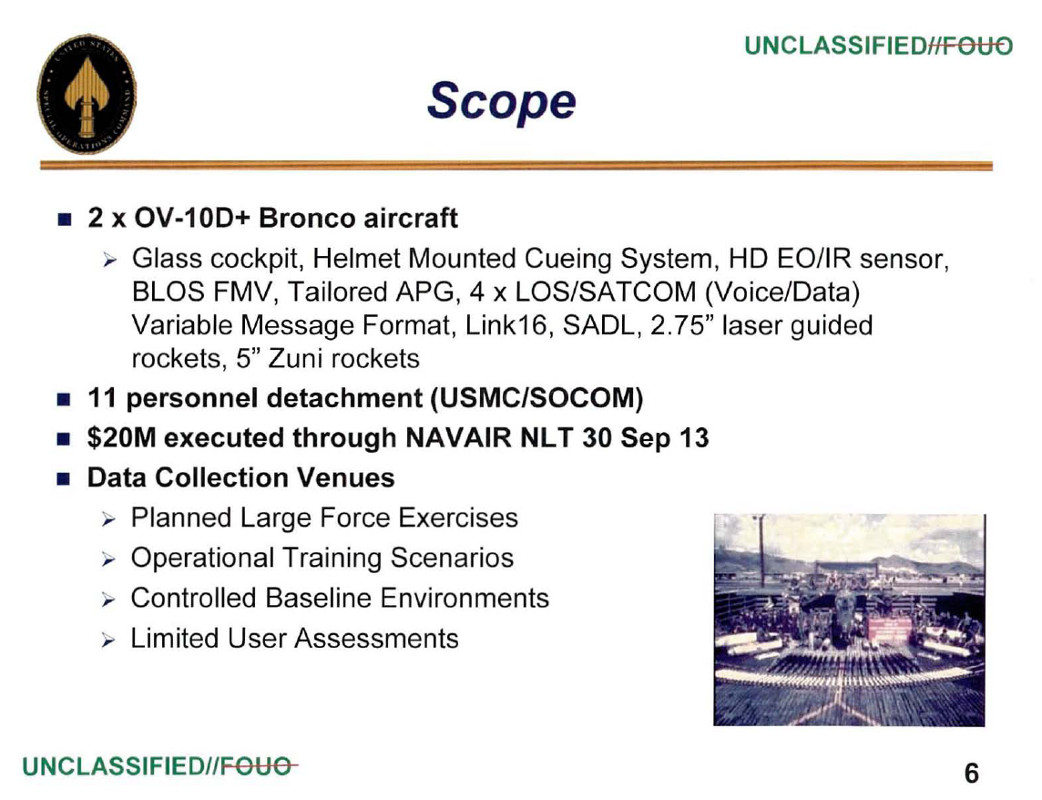
Each aircraft also had four Harris AN/PRC-117G radios. Also known as the Falcon III, these are multi-channel encrypted systems that can work either across line-of-sight or via satellite.
In addition to the APKWS II rockets, initial testing included loading the aircraft with the larger Cold War-era five inch Zuni folding-fin aerial rockets. We don’t know for sure if these weapons had a guidance system, but it seems hard to believe that this wasn’t the case given the aircraft’s focus on precision munitions.
In the late 2000s, the North American division of the European missile consortium MBDA had demonstrated a laser-guided conversion for the Zuni to the Marine Corps and Navy. To the best of our knowledge, this is the only such system available. Similar to the APKWS II, the new weapon used existing five-inch wrap-around fin rocket motors.
Unlike the smaller weapon, MDBA’s front end was entirely self-contained and would not have allowed the U.S. military to repurpose older stocks of Zuni warheads. There is no indication that the Broncos fired any guided Zunis during their subsequent deployment to Iraq.

But perhaps most interestingly, each one of the refurbished OV-10G+s had a specialized “airborne precision geo-location” system, or APG. This equipment would have allowed the aircraft to spot and track specific individuals based on the signal from a cellular or satellite telephone.
This targeting mechanism makes use of information the National Security Agency intercepts and has become a common, if controversial way for U.S. special operations forces in particular to target individual terrorist and militants. The U.S. military has nicknamed these strikes, which technical target only the phone in question, as “touchdowns.” Killing the person holding the device is a “jackpot.”
APG systems are already a key part of armed drone missions and U.S. Air Force AC-130 gunships have also used them to enable targeted strikes. It’s not surprising that SOCOM would have wanted to add this capability to the OV-10G+s given what we know of their concept of operations during their subsequent deployment to Iraq.
Tyler Rogoway had this to say in 2016:
“As far as just how precise the OV-10 crews could be with their laser-guided rockets and high-end targeting sensors, the Bronco’s prowess in this department was almost freakish. It wasn’t just taking out bad guys in windows—they were doing the same with fighters hiding under eaves, overhangs, dense cover and in doorways. Essentially, the Broncos were flying snipers for special operations forces hunting ISIS in Iraq. They could observe with great clarity from on high, collect intelligence and stalk the enemy. They could also kill that enemy with incredible accuracy. Instead of using a sniper’s bullet, the Broncos used the Pentagon’s guided munition equivalent, laser-guided rockets.
“One shot, one kill, even under the most demanding of combat conditions.”
Before that, though, a small detachment of 11 special operators and members of the Marine Corps set about training to operate the newly modified aircraft, beginning in February 2012. Four months later, the aircraft went to Jaded Thunder, a large, but obscure exercise the secretive Joint Special Operations Command runs so its operators can practice calling in air and artillery fire support missions with various aircraft and other assets from around the U.S. military, as well as foreign forces. Afterwards, the group traveled to Naval Air Station Fallon in Nevada, home of the Navy’s legendary TOPGUN program, to learn to fire the guided APKWS II rockets, before heading out for additional exercises.
And while the initial modifications had been in progress, between October 2012 and January 2013, personnel in the Joint Chiefs of Staff’s Joint Force Development office, or J7, poured over old studies, reports, lesson learned documents, books, and other material, and interviewed dozens of subject matter experts to get their opinions on what these new aircraft should be able to do. Not surprisingly, these reviews produced many common conclusions about the utility of airpower in limited conflicts – as well as highlighting an seemingly perpetual inability to either learn or apply those lessons from previous counterinsurgency and irregular conflicts.
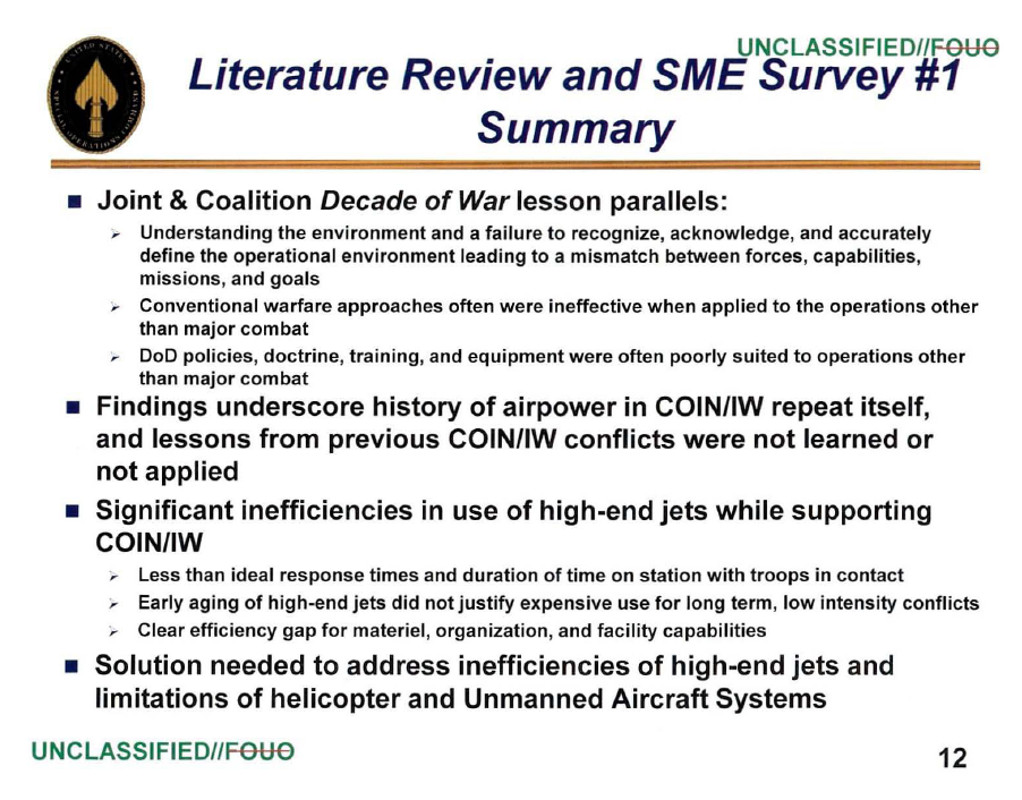
The experts were generally in agreement that there was a need for a cost-effective capability to fill a gap between helicopters and drones and high-end jet combat aircraft. In addition, they pointed out, as we at The War Zone have done ourselves, that this disconnect would only grow with the introduction of the F-35 Joint Strike Fighter.
“Find and fix capability with ‘longer time on station’ is the leading enabler for COIN/IW [counterinsurgency/irregular warfare] mission success,” one bullet point in the briefing notes. “Strong agreement by air component [subject matter experts] low-cost turboprop driven aircraft are essential to lower operational costs to fight/win long term COIN/IW conflicts.”
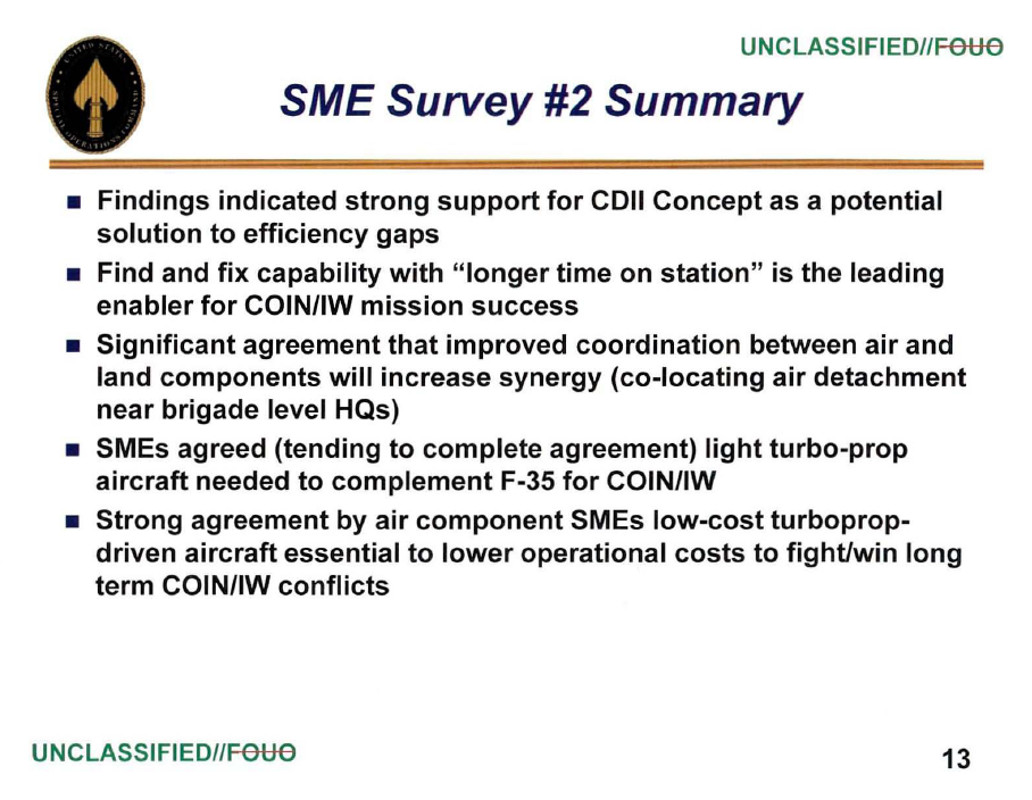
The J7 office rolled all of the data into what the U.S. military calls a Doctrine, Organization, Training, Materiel, Leadership and Education, Personnel, Facilities and Policy (DOTMLPF-P) analysis. There were a number of big takeaways.
According to the assessment, close air support doctrine itself was fine, though it could do with more counterinsurgency- and irregular warfare-specific guidance. There was a desire to make sure that commanders decentralized close air support assets to make them more responsive to the demands of smaller units.

This came along with the recommendation that the U.S. military should purchase one or two squadrons of light attack aircraft, an idea that the Marine Corps and members of Congress have both advocated for since then. Nearly 70 percent of the individuals the J7 assessors interviewed said that existing aircraft were not efficient choices for limited conflicts and a full 70 percent said specifically that a light turboprop aircraft was the right choice.
Those experts also said that any such light attack units would need new training to combine both close air support and other “non-kinetic” functions, such as forward air control and intelligence, surveillance, and reconnaissance.
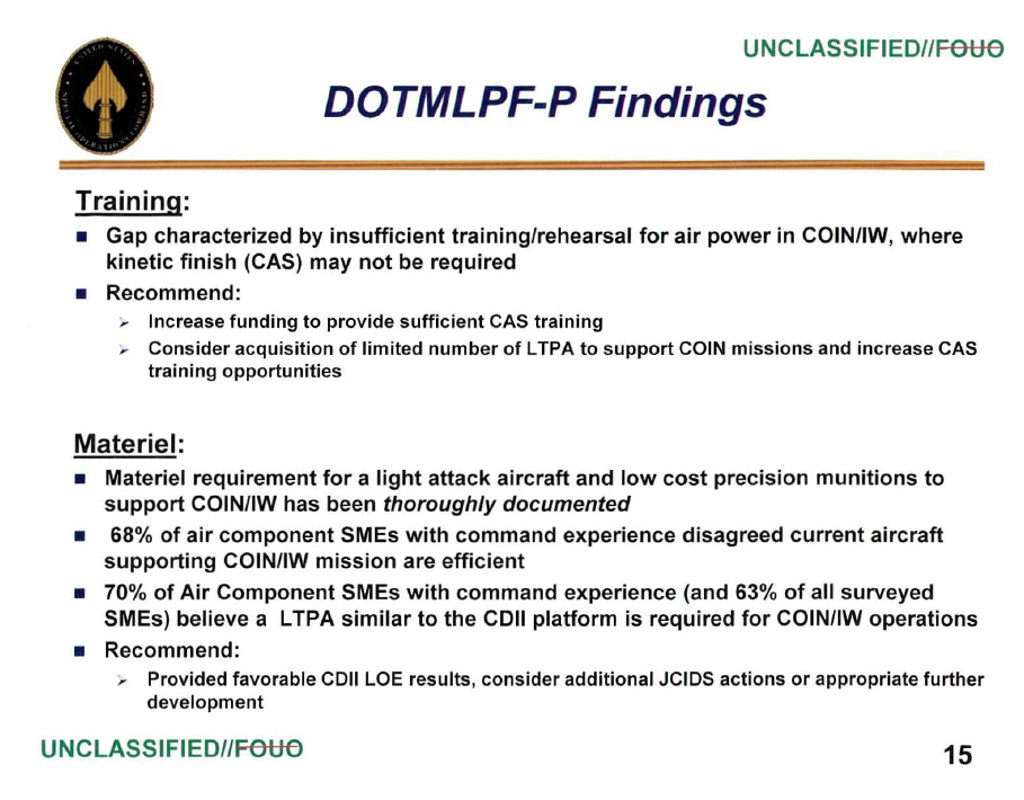
There would be a need to increase the number of joint tactical air controllers to help coordinate the activities of the new, forward deployed aircraft with ground forces, especially smaller conventional units, such infantry platoons or squads. Altogether, the officials in the J7 office estimated that using light attack aircraft to supplement high-end combat jets and other aircraft could save between $1 and $2 billion per year in the cost of operation.
SOCOM put those theories to the test in 2015 when it set the two Broncos to Iraq. By all accounts, they performed extremely well, but as we’ve already noted, the U.S. military never intended Combat Dragon II to be anything more than a proof of concept. The results of the project did have a direct impact on subsequent Air Force and SOCOM efforts, though.
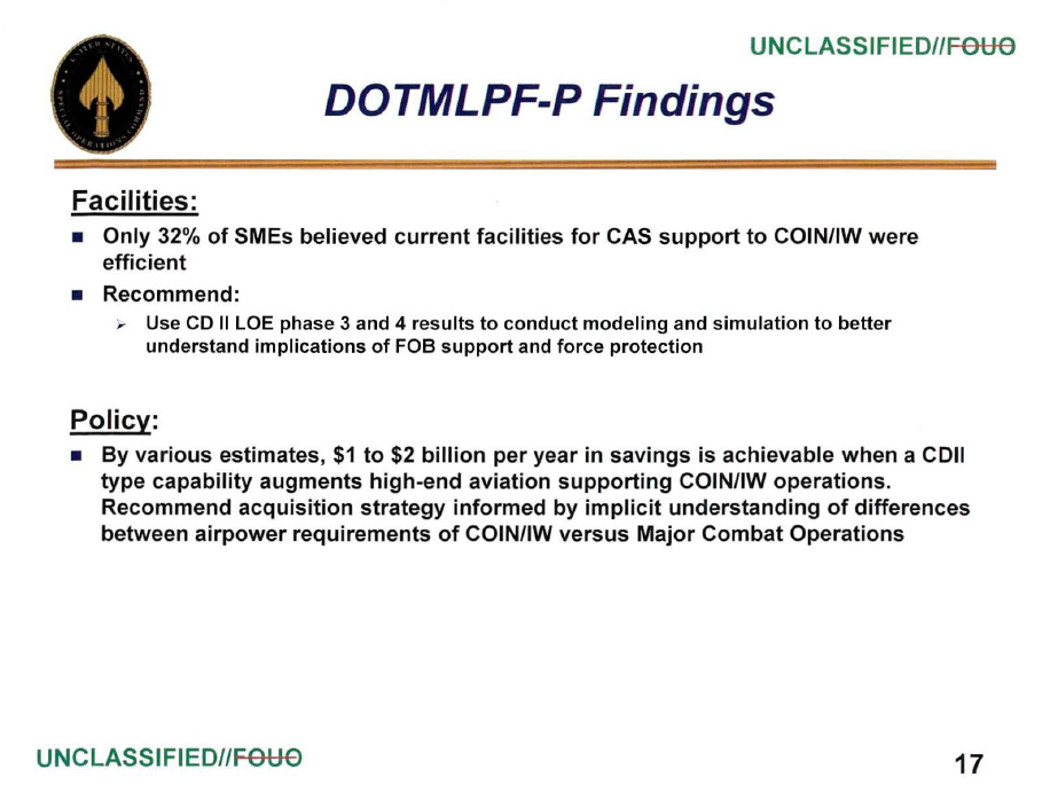
Earlier in 2017, the Air Force brought together various light attack aircraft for a demonstration program, which it nicknamed Combat Dragon III. Unfortunately, the service has yet to publicly release any findings from that test program, also referred to as OA-X, and plans to send one or more of the participating aircraft abroad for a combat evaluation have yet to materialize.
More importantly, SOCOM has begun its own its own complementary effort, which, like Combat Dragon II, is “platform agnostic,” focusing on desired capabilities and effects rather than specific aircraft and systems. You can find out more about the kind of tech the special operations community is looking for in its Light Attack Support Special Operations (LASSO) program, here.
With so many questions asked and information gathered during Combat Dragon II, along with other experiments before and after, its unclear why any more review and assessment of the concept is necessary. We don’t know how OA-X or LASSO will evolve in the near future, but in the meantime multi-role fighter jets continue to fly these missions at considerably higher costs.
As the experts noted during the Combat Dragon II experiment, it seems unreasonably difficult for these lessons to gain traction, despite the ever growing mountain of evidence. It’s clear that both conventional and special operations forces remain as interested as ever in the concepts the U.S. military explored with the two OV-10G+s.
Contact the author: joe@thedrive.com
